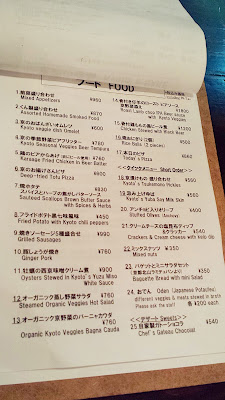There are multiple types of Japanese food categories you should consider putting on your Japan Eats list when you travel to Japan. Here’s my recommendation for 25 Top Japanese Food Experiences, aka a Japan Eating Checklist, including some photos and links recaps of those meals to encourage you.
If there is a place in Portland that has a similar dining experience, I will also include it on this list in italics in case you are curious but aren’t going to Japan yet. You’re welcome.
Before getting to my Things to Eat in Japan list, there are two books in particular that I highly recommend reading if you are foodie heading to Japan. First, is What’s What in Japanese Restaurants: A Guide to Ordering, Eating, and Enjoying by Robb Satterwhite. I carried this book wherever we went in Japan.
What I found valuable about this book is that it is divided into chapters based on the type of cuisine, and it has a full listing of possible menu items you might see. Each menu item includes the transliteration into a Roman alphabet of a dish so you can pronounce it to a server, a Japanese character version of the dish to point to a server or to try to guess if looking at restaurant menu, and then the translation/description of the dish and ingredients used. This came handy several times even when there were English translated menus at a restaurant so we could see what something listed as “ginnan” is (ginkgo nuts it turns out). Very practical.
The other Japanese foodie book that had me drooling and inspired is Rice, Noodle, Fish: Deep Travels Through Japan’s Food Culture by Matt Goulding. You don’t need to take this book along with you on the trip, but it’s great reading beforehand that gives history behind food and context behind some of the best food experiences in Japan with profiles behind restaurants, chefs, cities, and specific types of Japanese food. It is also just plain great storytelling and food writing. Reading each chapter is like a written version of a food and travel show in print.
Then, after getting the background, go to the accompanying free Roads and Kingdoms digital guide that lists out specific places to go to experience the food story yourself. Their curated list of where to eat and where to drink is seriously foodie legit.
Ok, here’s my ranked Top 25 Japanese Eating Experiences Checklist you should consider for your trip to Japan.
- Kaiseki Dinner, such as in a ryokan like we did is completely unique to Japan, admittedly can be a bit pricey but is so memorable. There is something you can only experience in Japan about sitting on a tatami mat in a yukata enjoying private room service with a table full of so many dishes like a buffet, before or after enjoying a soak in a hot spring. It will make you feel like the royalty and nobility that kaiseki originally was intended for.
Alternatively or additionally, you can also consider a kaiseki experience at a restaurant, including kaiseki which may be specialized such as ones that feature tofu like the one we had at Tousuiro, or ones that are completely Buddhist Vegetarian (also known as Shojin Ryori) like the one we had at Tenryuji in the Arashimaya area of Kyoto.
You should not be surprised at all to hear that if you want to eat the closest thing to kaiseki in PDX, I recommend that you should look to Nodoguro, which I have written about many times. Although they won’t serve your little dishes all at once like at a ryokan, they are the closest in crafting creative a similar experience, course by course like at a kaiseki restaurant. Another option for kaiseki in Portland is Chef Naoko, she does traditional Japanese presentations in red lacquered bento boxes, and she offers lunch too not just dinner. - Sushi Breakfast near the Tsukiji Fish Market. This remains the best sushi and sashimi I’ve had in my life because that freshness and quality is difficult to beat, no matter how quickly any other sushi restaurant acquires their seafood because this is the premier fish market in the world. My version of this iwas dining at Sushi Dai, which I recapped here but there are many super fresh places in the Tsukiji area you can find without having to necessarily wait for hours or getting frustrated walking around lost trying to find a particular place.
I say the closest to this kind of quality sushi you can get is through Nodoguro’s Hardcore Sushi Omakase. Another option is Fukami Sushiya which also does omakase. - If you’re in Kyoto, definitely try tofu, especially Yudofu or Yuba, because Kyoto tofu is the best tofu in Japan and possibly the world. Yudofu is a hot soybean curd dish where you add some sauce and toppings and showcases it’s fresh and clean flavors. I highlighted Kyoto tofu in a previous post. In general, always ask and look for local specialties wherever you travel in Japan. Particular in Japan, they are not shy about promoting and they take pride in what is unique and special to their area.
Although they don’t offer cooked tofu dishes as they are not a restaurant, in PDX my favorite tofu source is Bui Tofu and F loves the prepackaged lemongrass tofu they offer. - I am pretty sure that at least 4-5 times a day we were stopping at the Japanese drink vending machines to get a beverage. I am so sad that in the US we don’t have anything like this on all the street corners like Japan does. Even when we were climbing Mount Takao, somehow many drink machines had been hauled up there to hydrate all visitors. The red labeled drinks mean that it is hot, and the blue labeled drinks mean they are cold. Not all of the containers may be drinks like water, tea, juice or coffee – some may be beer, sake, even curry or soup so look carefully! The machines usually either take money as well as you can just scan your transit card, which is very cool.
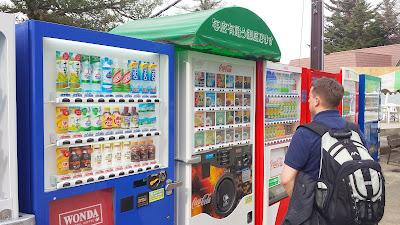
In the US, I haven’t seen this kind of machine except in Hawaii. The closest you can get is to buy the iced coffee cans at Uwajimaya - I have yet to have Tonkatsu, or a fried breaded pork cutlet, usually a filet or loin, in the US as good as what I’ve had in Japan. I think in Japan that they do a better job of sourcing high quality pork for the dish such as Kurobuta, also known as English Berkshire pork that is marbled with fat so it doesn’t dry out. I’ve had versions so flavorful and juicy I ate them with no sauce. The coating as you can see is thick, but it’s not greasy or oily.
In some cases besides the pork cutlet you can also get a combo that includes a minced patty or shrimp, sometimes you can also get chicken, cheese, and crab meat croquettes. Either way it is always served with a lot of shredded lettuce, miso soup, a few pickles, and rice. This so crispy outside and succulent inside is only good when fried fresh – don’t shortcut to prepared boxes of Katsu at the store because it won’t be the same. However, just like me, once you have the perfect kind in Japan, you may be ruined for all other paler imitations in the US of tonkatsu now.
Unfortunately I don’t have any tonkatsu place that I can recommend in Portland – do you know of one? I know a few places offer it as a single dish (not different options of Tonkatsu where you can select from different pork or other items that are also fried in the same batter coating), but nothing that stands out to me… No one has that above perfect crispy coating texture that I’ve seen? One spot on my list to try offering Tonkatsu is Pono Farms, has anyone been? I’ve also enjoyed the potato croquettes at ramen stop Kizuki (formerly Kukai). The batter isn’t the same but you can reliably get pork Tonkatsu at Chef Naoko’s Shizuku - Crepes in Japan can be found everywhere, but most famously in Tokyo in the trendy youthful fashionable neighborhood of Harajuku. The crepes are formed in a way that is mind boggling what they roll into there – not just fruit and whipped cream and chocolate sauce, but think also multiple scoops of ice cream, even a slice of cheesecake. It is more decadent that the flatter crepes on a plate inspired more from France, which is usually what you find in the US. In Japan, they roll the crepe all up in a cone of paper for you to eat instead of on a plate with silverware, which is fun. Famous stands like Angels Heart offer 75 different options to choose from.


Meanwhile others like these from Momi & Toy’s in Tokyo Station offer classic as well as unique flavor combos, like the chestnut and pistachio crepe, and always reliable strawberry and cream before shopping Tokyo Character Street.
Why are there not more options I’m Portland for this awesome dessert… I know of Mojo Crepe at SE 82nd and Division only offering Japanese style crepes in cones. Stop by and encourage them! - Make an effort when in Japan to try Japanese Snacks along the street, especially by temples and shrines, like I covered in my previous Japanese Treats at Temples and Shrines post. Since that was a whole checklist in of itself, follow the link over there for more details though my favorites tend to be Dango and Amazake which are pretty ubiquitious.

I don’t know of any equivalent in Portland unfortunately for the snacks except to visit a Japanese supermarket like Uwajimaya. - Unlike most of Asia, there isn’t a strong street eating culture in Japan, so you won’t usually find food carts or outdoor food courts with open air eating from multiple vendors. So, if you are visiting and there is any kind of festival going on, make sure to stop and enjoy as there will likely be food booths at a Japanese festival!
The next closest thing in Portland is to try to attend one of the Japanese festivals that sometimes occur such as the annual January/new year Mochi Festival August/summer Obon Festival. Travel Portland has a great list of Japanese American events. - I’m not sure any explanation is necessary on why you should try ramen in Japan. There are so many styles and it varies by all the various prefectures, so even traveling from city to city in Japan you should check out the ramen. Variances include what exactly they do to create the broth, flavorings of the broth, type of noodle, what they do in creating the homemade noodles, and types of toppings offered that result in a huge matrix of possibilities. I cheated a bit and we went to the Ramen Museum as I posted about earlier in order to get a bunch of different ramen but all in one place, so that was a ramen theme park approach. Other options would be to visit a ramen street, such as at Tokyo Station or Kyoto Station to get access to multiple ramen places at once.
In PDX, for authentic Japanese I like Marukin Ramen inside the city if you just want to focus on ramen (I covered all their ramens here), and Kizuki (formerly Kukai) in Beaverton for ramen along with additioanl izakaya dishes like rice balls, takoyaki, fried croquettes, etc. or Mirakutei if you want ramen and sushi or modern Japanese tapas like I had this visit. For inauthentic, I like Boke Bowl and make sure you get the buttermilk fried chicken with mustard aioli add on along with the slow poached egg and the pork belly – that’s the combo I always use since I’ve been a fan sice when they were still a pop up at Decarli and pop up at Oba. - In other noodle news, you should consider having cold soba with a dipping sauce, which is called Mori Soba rather than when the noodles are already in a broth. Generally these restaurants will also offer udon. I prefer the soba with the dipping sauce because the soba noodle is served cooked and cold which helps me taste the noodles better, and is comforting without heating you up because of hot broth like ramen does. The most common broth accompanying the dish is in the first photo, Tsuyu, a broth/sauce made from mirin, dashi, and soy sauce that you add your desired amount of wasabi and scallions before dipping. For that particular dish (Zaru Tanuki Tororo Soba) it also came with tanuki which means served with tenkasu, crunchy bits of leftover fried tempura batter, and also tororo, gelatinous grated yam. The zaru designation means that the buckwheat soba noodles in the basket comes with seaweed on top.

This second version is my favorite version, Kurumi Soba which comes with a walnut miso dipping sauce. At the end we’re given a small container of warm water left from cooking the soba to add to the leftover Dipping Sauce to optionally finish the eating the sauce as a soup.
I don’t know of any soba specialty restaurants in Portland, do you? The closest is Yuzu in Beaverton which offers 5 soba dishes. - If you are open to a little alcohol, check out yakitori izakayas, or drinking pubs featuring skewered charcoal grilled chicken. Yes, you can find yakitori also in the US, but I found the experience in Tokyo has a grit that just can’t be replicated. There’s something that feels so urban underworld about the famous izakaya alleys where there are multiple of these hole in the wall grilled meat and drinking joints, each one lit by a red lantern such as at Omoide Yokocho also known as Memory Lane or ‘Piss Alley (Go Tokyo has a great list of Yokocho). In reality you are more likely sitting with salarymen than yakuza though.

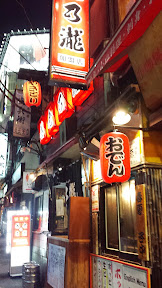

You should know that first and foremost these are drinking establishments, so order a drink! The food is a accompaniment to drinking, and don’t be surprised when you get thirsty eating as it is salty food. At some yakitori bars you are given a small dish or snack/otoshi that you did not order – it’s their way of justifying the forced per seat minimum charge. You should also be prepared to smell like smoke when you leave, and in some cases its’ a common bathroom outside because the bar itself is so small, fitting only a dozen people. Be also aware that there are lots of interesting meat types that may be on skewers so be cautious of just pointing at Japanese characters on a menu or chalkboard without a translation…

You should definitely to make sure to get some chicken though there are also some vegetable options such as ginnan (gingko nuts) and egi (leeks). Many of the top chicken can be found at yakitori, as they may advertise the chicken DNA is heirloom or more than half native, and from small farms and free range – there are even specific regions that may be referenced that the chicken is from.
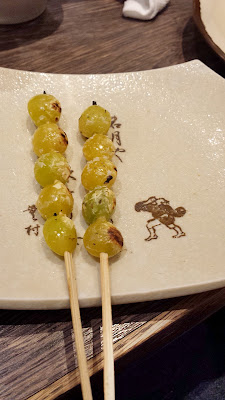

For yakitori in PDX I know of Biwa‘s and Shigezo / Maru, although the skewer selection is smaller than a Japanese dedicated yakitori place, and it feels too nice in there to be too boisterous like you would in a yakitori alley. But plus, it’s not in an alley! - Whenever we were going on a hike like up Mount Takao or wanted to pack along snacks in our bag to carry with us, our constant companion was Onigiri. This is a staple you can find at all the convenience stores and also at department stores – my favorite was in Shinjuku at Momichi, which inside one of those incredible food basements (in this case Odakyu Department Store) was a counter that has 47 choices, 1 onigiri style/flavor from each province. I suggest you visit both Convenience Stores (Konbini) and Department Store Food Basements to soak up the regular Japanese citizen’s food shop, and then grab an onigiri or two or three for your bag.
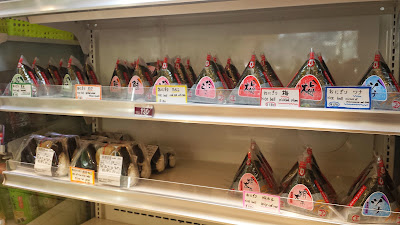
Some stores will have English translations of the contents, but many do not so I printed out the Google Chrome translated version of the ones at Momichi with help from RocketNews24 article on eating all 47 and just checked off which ones we wanted to give to the counter lady. In convenience stores common flavors you will find are pickled plum, salmon, cod roe, spicy tuna, kelp, natto, and a seafood with mayo like tuna or shrimp (you can see a rough guess of the English and Japanse character by looking at this RocketNews24 article on top onigiri fillings).
For onigiri in Portland, visit the cute teahouse and snack shop Behind the Museum Cafe right across from the Portland Art Museum or get takeout from Musubi. If you want to try it as part of a larger meal, check out Biwa or Kizuki (formerly Kukai). - Kushikatsu or kushiage is a meal of breaded meat, fish, or/and veggies or cheese which are skewered, deep fried, and that you then you dip into a Worchester-like tonkatsu sauce and eat with cabbage leaves. It’s a bit like a fondue with oil, but they do all the smelly deep frying for you in the back and then rush it out to you. The sauce is in a communal container so double-dip is a big no no. You can order your skewer one at a time, or purchase a set that has an assortment like the one I had that included an additional side. I shared details about eating at the most famous of kushikatsu chains in Osaka, Daruma, on my blogpost on Osaka previously. The pairing to eat with kushikatsu is usually an alcoholic beverage, like a whisky beverage or here I had shochu.
Do you know where PDX offerings of kushikatsu or kushiage might be? I don’t 🙁 - Tempura in Japan is a meal of deep fried vegetables and seafood. There are restaurants in Japan where instead of an assortment of vegetables and perhaps some shrimp that you might normally get in the US with a tempura appetizer order, you can actually order by the piece. And, in Japan they make a concerted effort to get it to you while it’s hot, and they are much more conscientious than most places in the US in having just the right amount of batter but not too much, and not too long that it gets oily. I recommend starting with a set which will give you an initial foundation of some tempura, along with rice, pickles, and soup and then ordering additional pieces from there.
The key is you want it as crispy as possible – this means as quickly from the vat to your mouth without burning your tongue, and only the slightest amount of dipping sauce so it doesn’t get soggy. Because of the amount of deep fried a meal like this might be, having a beer whose carbonation and lightness can balance the tempura is also ideal. The batter is different, so tempura is a lot lighter kushikatsu.
In PDX, the tempura a la carte menu I’m describing here can be found at the unassuming Takahashi Restaurant. - Takoyaki are octopus dumplings, a street food representative of Osaka. Generally you will see takoyaki at a small food stand, being made hot and fresh from the special takoyaki grill. Be careful eating it – it’s hard to be patient, but if you aren’t you can burn your tongue pretty badly. Depending on the stand there may be a variety of possible special sauces or toppings you can add. I covered my takoyaki eating in Osaka previously and I also see it at booths at festivals like you see below too.
My recommendation is food cart Buki, as I’ve written about before. I appreciate that they specialize just like in Japan to focus on being good at takoyaki. - Another Osaka specialty, but also often found at street stalls, is Okonomiyaki. Okonomiyaki is a kind of griddled Japanese pancake that includes batter, shredded cabbage, and other ingredients and toppings which vary but generally include okonomiyaki sauce, mayo, bonito flakes, and seaweed flakes. You usually have it prepared either by the chef or you make it yourself at the table. I had it at Ajinoya in Osaka as I noted in my in Osaka post previously, but I also see it at booths at festivals like you see below too.
Unfortunately I don’t have any okonomiyaki place that I can recommend in Portland – why do you know of one? I know a few places offer it as a single dish but not with options like an Okonomiyaki joint in Japan would – as a single dish option you might consider Shigezo / Maru or Bamboo Sushi. - Enjoy Japanese Curry, this one is from Coco Curry House which is a curry restaurant chain. Japanese curries are commonly eaten and are very homey, but are not generally found as often in the US so take advantage while in Japan to try some. They can be customized in terms of what kind of curry, what kind and number of toppings and what level of heat.
When it comes to Japanese curry in PDX I go to Kalé - Sweets in Japan are created so artfully that sometimes it seems unreal – I can barely tell the difference between a plastic model and the real thing. There are a variety of different places to enjoy dessert, be it at a restaurant, in a cafe with coffee or tea, or even purchasing it from the department store basement food floors or from a store in a train station. Don’t miss out on these edible art that are available so casually. Make sure to eat a fancy Japanese dessert – they are so affordable.



For specific Japanese take on dessert, look no further than Yume Confections or Mio’s Delectables. If you are looking for more of a dessert cafe, try artful desserts from Papa Haydn and Pix Patisserie which are more French. - Conveyor Belt Sushi – now automated! Conveyor Belt Sushi restaurants are essentially like fast food dining in which you sit at a counter. A tap at your seat provides hot water for green tea, and usually you have a motorized parade of sushi plates that you just grab whenever one catches your eye, or it may be the kind you order from a screen. Stack the plates as you eat because you will be charged based on the number of plates, with certain color plates representing different price points.
It may not be as fresh as experience #2 above by Tsukiji market, but prices are reasonable, and if you go at a busy time where they keep making new dishes, or one where they make it to order, it will still be pretty fresh. Now, the latest upgrade on the conveyor belt parade is automated delivery of specific sushi. We went to Genki Sushi in Shubuya, where you order from individual tablet screens at your seat from a menu (there is an English menu available) and then the dishes come essentially via a sushi train programmed to stop directly at your seat. With three tracks, food came out very fast. And, because each was a specific order they offered a HUGE menu of dishes we could choose from.
Let’s not kid that this is the best sushi in Tokyo- it’s just a more techie version of conveyor belt sushi that lets you tailor your order to get what you want and reduce waste and human resources (servers) for them. As a customer though is also incredibly convenient to be able to get exactly what we want instead of watching a parade to see what is available by scrolling through the menu instead. You can order 3 dishes at at time since that’s what the train holds, but usually stuff comes one plate at a time as soon as it’s ready. There were yellow smiley buttons to send the train back after we had picked up our plate, to go containers already at the seat, and after ordering a certain amount of plates you even got to play a scissors paper rock game to possibly win food or discounts. Fun!
There are locations of Genki Sushi also in the US in Hawaii and in Santa Ana, California and in King County, Washington - Have you ever heard of Mentaiko Spaghetti? It is essentially a Japanese Style Fish Roe Pasta that is reminiscent of Pasta Carbonara in that it has a creaminess and saltiness for the flavors, but instead of using bacon it uses cod roe, aka mentaiko, which are those little dots instead. You can probably find this at a lot of Italian restaurants in Japan.

You used to be able to find this dish once a week as the Saturday special at Noraneko but they changed their menu to be ramen and sandwiches now, sadly, even though their version is as good as the ones I had in Japan. Does anyone else know where to get this now? - When you are at the train station, look for the Ekiben store selling Eki Bentos – these are train bento boxes packed so you can enjoy them on the shinkansen bullet trains. The ekiben are only at stations where the shinkansen go through – and you will find it in the station stores and restaurant area and also on the platforms. They are already packed, often with a display showing what is inside, for you to take to go. The Ekiben stores in the main station tend to have much larger selection than the one on the tracks.


Although there may be some classics that are available at all stations, you will also notice that there are regional specialties that vary depending on which station you purchase. Every train station we went through I always kept an eye out to see if there were ekiben stores to admire the possibilities, as well as looking for train stamps. Here are a few that I enjoyed during my trip – and I encourage you to try them too to get a full shinkansen experience.



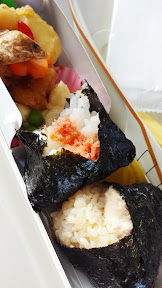
- Often found near the train stations are these fabulous Japanese bakeries – you go in and grab a tray and tongs. Then, you walk around filling your tray with any of the baked goodies you want, which vary from savory to sweet. Then, you bring your tray to the cashier to pay for it all and they will wrap them up individually. I love stopping at these to grab buns for breakfast or as a snack.
The closest equivalents is Oyatsupan in Beaverton. Alternatively try Chinese bakeries that offer sweet and savory snack buns like King’s Bakery (SE 82nd and Division), Mei Sum Bakery (SE 80th and Powell), and Meianna Bakery (by Fubonn). I’ve grabbed some of the savory rolls from Best Baguette (at least I know the Beaverton location has it) - During the cold weather months, look out for Oden, a broth made by simmering fish cakes, fried tofu, and vegetables in a kelp based stock. There are usually lots of possible individual pieces of items you can purchase by the item to add to the broth, and you eat it with a little bit of mustard. After passing these countless times in convenience stores, I finally decided to try it.


I got daikon (the round thing to the bottom right), Konnyaku (looks like dragon hide but root of a plant call the Amorphophallus konjac, sometimes referred to by well-meaning English-speaking Japanese as “devil’s tongue”) and Tsukune meat thing. I really wanted a Mochiiri Kinchaku or “tofu purse” but the store didn’t have any. For a great primer on oden and what each of the ingredients are, I’m thankful for RocketNews24 Diner’s Guide to Oden. Other soup dishes that you might want to try in Japan include the one pot dishes of shabu shabu and sukiyaki (in which you swish beef into the soup to cook – broth based fondue essentially), or the heartier stews that is a staple of sumo wrestlers diets, chankonobe.

A lot of the hot pot joints in Portland tend to be Korean or Chinese (I like Hot Pot City, conveniently close to my home by PSU and offers vegetarian) - Since my latest visit was with a vegetarian, and because the beef can be expensive, I didn’t make it to a restaurant serving Kobe Beef. You can eat it raw like sashimi, swish in broth sukiyaki style, bbq grill it via yakiniku cuisine, or have it teppenyaki style on an iron plate teppan grill. Unlike the teppanyaki in the US, the ones in Japan may be upscale steakhouses with premium cuts of meat, not just offering the entertainment value of the chef grilling in front of you. If you love steak though, you should seek out the famous marbled Wagyu Kobe Beef. The whole Japanese Kobe Beef and American Japanese “Kobe” Beef is a PITA to sort through so I haven’t made any effort here to justify whether they are equal or which is better. Tokio Table does offer teppenyaki and Wagyu from Snake River Farms,and you can try certified Japanese Wagyu if you attend Nodoguro SupaHardcore dinners.
- Live on the edge by eating Fugu. This still hasn’t been an experience I’ve had – still not sure if it ever will. But I can’t deny that it should be part of a possible Japan Eats list. It’s definitely a specialty of Japan to eat this known poisonous fish at one of the licensed restaurants offering pufferfish / blowfish. It is in season mainly in the winter, and because of the special training can be a little more expensive. Once inside the restaurant, there will be multiple preparations of fugu that you can choose from, varying from hot and cold, cooked and raw. For more information, try this New York Magazine article on eating fugu.
On a more reasonable note, I would do this for crab (kani) – the famous moving crab sign in Osaka is the symbol for a crab restaurant chain called Kani Doraku that specializes in crab dishes. I didn’t have enough room for it in this past trip (plus probably wouldn’t have been appreciated by F who wouldn’t be able to eat anything as a vegetarian), but if I went to Japan again I would try it. Kani has locations outside Osaka – the blog Appetite for Japan has a great recap of what a Kani Doraku meal can be like.
No place in Portland is licensed for fugu, I think you’ll have to go to Seattle, New York or California
There is one other Japanese dining experience you might consider during a trip to Japan. I considered it but didn’t want to spend that much when F couldn’t be part of the experience. That’s dining at one of the Michelin starred restaurants. As of 2016, Tokyo has the most Michelin starred restaurants of any city in the world with 13 Three Stars, 51 Two Stars, and 153 One Star Michelin restaurants. The type of cuisine a Michelin star restaurant may offer varies greatly.
I also want to mention though it doesn’t count as eating, definitely consider trying local sake and craft beer while in Japan as well.
- In Tokyo we visited Baird Brewing which offers several taprooms all specializing in a different bar food to go along with the beer (we went to the one in Harajuku where we tried a few tofu izakaya items with our beer and I fell in love with Wasabi Potato Salad), an outpost of Little Delirium offering Belgium Beer in Shinjuku, Mikkeller Tokyo in Shibuya offering rare beers you normally only see in bottles, and Good Beer Faucets also in Shibuya offering an impressive 40 taps (They were having a special event where as they blew their taps the price of the beer would be discounted until we drank all their beer and they closed for the New Year’s weekend). For the most taps in Tokyo, look to Popeye’s with it’s 70 beers on draft and one ugly mofo of a website.
- In Kyoto, we went to hole in the wall but high quality craft beer and organic food bar Beer Komachi, and Jam Hostel Sake Bar as I’ve mentioned before I enjoyed tofu with beer and had the best sake ever, and another option would be trying both beer and sake as both are available at Kizakura Kappa Country.








Which Japanese Eats do you think you would put on your list? What have you already tried and loved in Japan, or though eh it wasn’t all that? Did I miss anything in my list? Are there places in Portland for some of these that I don’t know about that you want to loop me in on?
Thank you very much for reading my long series of my Japan Travel posts. This is the last one, and at this point I’m a little perplexed myself how I managed to fit in so much in the 2 weeks I was there. Is it wrong to be impressed with your own travel planning? Although we did a lot, I also felt it was a relaxing vacation because we were never rushing from place to place on a set schedule and that there was some flexibility in the itinerary. Did I miss my calling as a travel and tour operator?
Next week Travel Tuesday I’ll be taking you to Sante Fe!
Here’s a summary of my Japan Travel post series:
- Guide to Planning a Trip: Research
- Guide to Planning a Trip: Mapping
- Hagoita Ichi Winter Festival at Sensoji Temple, Japan
- Japanese Treats at Temples and Shrines
- Winter Illuminations in Tokyo (Winter Season – November – February!)
- Snow Monkeys in Hot Springs
- Onsen by Mount Fuji covers Onsen 101 and how we loved our stay at Lake Kawaguchiko
- Dining at a Ryokan a look at what a traditional dinner and breakfast might be during a ryokan stay
- Visiting Cup Noodles Museum in Yokohama (just outside Tokyo)
- Visiting Shin Yokohama Ramen Museum
- Kyoto Temples and Shrines (walking tour starting in Higashimaya with stops especially at Kiyomizudera Temple, Kodaji Temple, Heian Shrine)
- Kyoto Temples in Arashiyama
- Kyoto Tofu
- Kyoto Famous Sights of the Kinkakuji (The Golden Pavilion) and Fushimi Inari (Red Torii Gates)
- Famous Signs of Osaka and eating Osaka Food specialities like okonomiyaki, takoyaki and kushikatsu
- Visiting Himeji Castle, the famous white castle in Japan
- Fun at Japanese Cafes and More including Maid Cafe, Cat Cafe; theme parks of J World and Namja Town, a geeky stop at Kanda Myojin, and Ghibli Museum
- Japan Eating Checklist is my top 25 list of things to try to include as an eating experience when visiting Japan
- New Year’s in Japan: Oji Fox Parade, and some photos of a Meiji Shrine visit on New Year’s Day











